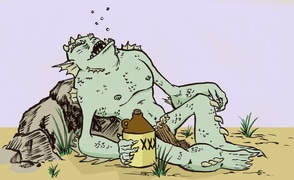view/download (PDF)
|
I.S. Gabashvili "The Incidence and Effect of COVID-19 Vaccine Adverse Events on Breakthrough Infections: Decentralized Observational Study that Includes Underrepresented Groups." JMIR Form Res. 2022 Oct 29. doi: 10.2196/41914. [Epub ahead of print]
view/download (PDF)
0 Comments

Nobody likes strong smells coming from other human beings. It's just that social convention: you are nice, if you smell nice, and you are a monster - like Shakespeare's Caliban - if you smell bad.
Caliban, often depicted as a Golumn-like creature, is one of the first cases of fish odor syndrome described in the literature. No amount of soap and water would help him to wash the smell away, as his body is constantly producing a pungent small molecule trimethylamine. Caliban is likely to bore a brunt of a genetic misfortune - an error in the gene coding for Flavin containing monooxygenase 3, aka FMO3. However, as the recent article published by Dr. Preti's team shows, it could be also caused by mutations in a number of other genes in FMO3 pathway. Even worse, as observed by Dr. Callewaert, some body odor conditions could be more like "infections" - e.g., picked up by sleeping in a dirty bed or using a contaminated washing machine. Humans are awash in microbes; they cover our skin, live in our nose and mouths. Very little dis-balance could affect the symbioses and create colonies of displeased microbes generating smell. Sometimes it is not even describable as smell - as in PATM - "people alelrgic to me" condition that causes those surrounding the sufferer to exhibit a range of sensitivity reactions - from sneezing and coughing to rubbing their eyes. These conditions are difficult to study. But we should study them, as we need to give the underserved the care they deserve. Join our Livestream today at 10 am PST to learn more.
REFERENCES
Guo Y, Hwang LD, Li J, Eades J, Yu CW, Mansfield C, Burdick-Will A, Chang X, Chen Y, Duke FF, Zhang J, Fakharzadeh S, Fennessey P, Keating BJ, Jiang H, Hakonarson H, Reed DR, & Preti G (2017). Genetic analysis of impaired trimethylamine metabolism using whole exome sequencing. BMC medical genetics, 18 (1) PMID: 28196478
Callewaert C, Lambert J, & Van de Wiele T (2016). Towards a bacterial treatment for armpit malodour. Experimental dermatology PMID: 27892611
Kubota, H., Mitani, A., Niwano, Y., Takeuchi, K., Tanaka, A., Yamaguchi, N., Kawamura, Y. and Hitomia, J. (2012) Moraxella species are primarily responsible for generating malodor in laundry. Appl Environ Microbiol 78, 3317–3324. Takeuchi, K., Hasegawa, Y., Ishida, H. and Kashiwagi, M. (2012) Identification of novel malodor compounds in laundry. Flavour Fragr J 27, 89–94. Bockmühl DP. Laundry hygiene–how to get more than clean. Journal of Applied Microbiology. 2017 Jan 1. DOI: 10.1111/jam.13402 Worst of flu season may be over. But you can still catch a chill. If you shake hands with lots of sick people, for example. Or don't keep sufficiently warm. Yes, your mother has told you, and you thought it was just an old wives' tale, but it wasn't.
Many illnesses are associated with distinct odors. Especially those caused by infectious or opportunistic microbes inside the body or on its surfaces. Body odor of someone infected with C. difficile, for example, can appear "swampy", Rotavirus gives sharply sweet putrid smell that some people associate with wet dogs, H. pylori can create a range of foul odors, and pseudomonas infections can smell like grapes and bitter almonds.
|
Categories
All
Environment
|

 RSS Feed
RSS Feed
